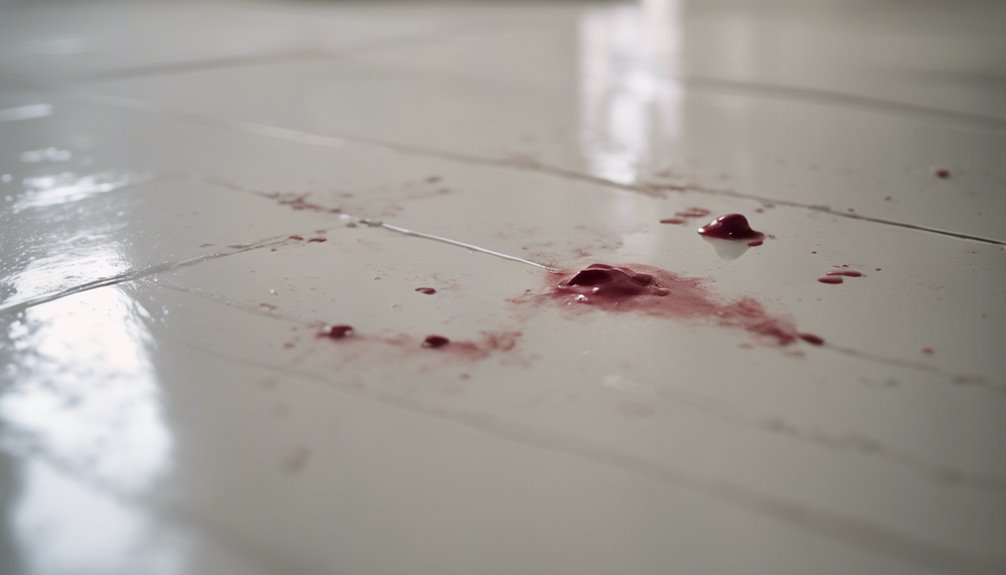To remove paint from your vinyl floor, first determine if it's latex or oil-based. For latex paint, use warm soapy water and a soft cloth to scrub gently. If it's oil-based, grab rubbing alcohol or mineral spirits and a stiff brush. Always test a small, hidden area first to verify your cleaner won't damage the vinyl. For stubborn stains, you might consider a commercial paint remover, but use gloves and guarantee good ventilation. Afterwards, clean the area with a damp cloth to remove any residue. There are more tips to help you achieve the best results.
Assess the Type of Paint

How can you determine the best way to remove paint from your vinyl floor? First, you need to assess the type of paint involved. Different paint types, like latex or oil-based, require distinct removal methods. Latex paints are generally easier to handle, often coming off with warm soapy water or a gentle scrub. On the other hand, oil-based paints may demand stronger solvents like mineral spirits or paint thinner, which you should use cautiously to avoid damaging your vinyl. Identifying the paint type not only saves you time but also guarantees you choose the right approach, keeping your floor intact while reclaiming its original beauty. So, take a moment to inspect before diving into removal!
Gather Your Supplies
Before you start removing paint from your vinyl floor, it's important to gather the right supplies. First, identify the paint types you've dealt with, like latex or oil-based, as this will determine the cleaning tools you'll need. For latex paint, grab warm soapy water and a soft cloth or sponge. If it's oil-based, you'll want a solvent like rubbing alcohol or mineral spirits, along with a stiff-bristled brush or scraper. Don't forget gloves to protect your hands, and a bucket for easy cleanup. Having paper towels handy is also wise to blot excess paint. With these supplies ready, you'll be well-equipped to tackle that paint and restore your floor's beauty. Freedom from mess awaits!
Test a Small Area

Before you start removing paint, pick an inconspicuous spot on your vinyl floor to test the cleaner. This way, you can see how the material reacts without risking visible damage. Make certain to use the appropriate cleaner for your specific type of paint to guarantee the best results.
Choose Inconspicuous Spot
Where should you start when trying to remove paint from your vinyl floor? First, you need to choose the right location for your test spot. Look for an inconspicuous area that minimizes potential damage. Before proceeding, check the flooring condition to verify it can handle the cleaning method you plan to use. Here's how to select your spot:
- Near an edge: Choose a corner or along a baseboard.
- Under furniture: Look at areas hidden by rugs or heavy items.
- In a closet: Test inside a closet where it won't be visible.
- Discolored areas: Use spots with existing blemishes for less risk.
This way, you'll feel more confident about removing that paint without fear of ruining your flooring.
Use Appropriate Cleaner
Once you've identified a suitable test spot, it's crucial to select the right cleaner for your vinyl floor. Not all cleaning solutions are created equal, so look for those specifically designed for vinyl surfaces. Avoid harsh chemicals that could damage your floor's finish. Instead, opt for gentle, effective cleaners that promise floor protection while removing paint.
Before applying any solution, test it on the inconspicuous spot you chose earlier. This step guarantees compatibility and prevents unwanted damage. Apply a small amount of cleaner, let it sit for a few minutes, then wipe it away to see how your floor reacts. If it looks good, you can confidently use that cleaner on the paint-stained areas.
Use Soap and Water
To effectively remove paint from your vinyl floor, start by gathering your supplies, including warm water, dish soap, and a soft cloth or sponge. Once you have everything ready, use a gentle scrubbing technique to avoid damaging the vinyl surface. This method can help lift the paint without much hassle.
Gather Your Supplies
Before you start tackling that paint stain, it's vital to gather the right supplies, particularly soap and water. Having the proper paint removal tools can make all the difference in protecting your vinyl floor's surface. Here's a quick list of what you'll need:
- Mild dish soap – For effective cleaning without harsh chemicals.
- Warm water – Helps to loosen the paint.
- Soft cloth or sponge – To gently scrub the area without scratching.
- Bucket – For mixing your soap solution and keeping things organized.
With these essentials in hand, you're well-equipped to remove that stubborn paint while ensuring your vinyl floor remains unharmed. Remember, a little preparation goes a long way in achieving that fresh look!
Scrubbing Technique Tips
Start by dipping your soft cloth or sponge into the warm, soapy water solution. Wring it out to avoid excess water, as you don't want to soak the vinyl. When tackling the paint spots, use effective pressure with your cloth or sponge. Begin with gentle circular motions to lift the paint without damaging the surface. If the paint's stubborn, increase the pressure gradually, but don't go overboard. Remember, scrubbing techniques can vary based on the paint and the vinyl's durability, so adjust accordingly. Rinse your cloth regularly to avoid spreading the paint. Once you've removed the paint, wipe the area with a clean, damp cloth to remove any soap residue, ensuring your vinyl floor stays in great condition.
Try Rubbing Alcohol

If you're dealing with paint spills on your vinyl floor, rubbing alcohol can be a game changer. It's an effective solution for paint removal without damaging your flooring. Here's how to use it:
- Gather Supplies: You'll need rubbing alcohol, a clean cloth, a bowl, and some warm water.
- Test a Spot: Before diving in, test the rubbing alcohol on a small, inconspicuous area of your vinyl to verify it won't cause discoloration.
- Apply Alcohol: Soak the cloth in rubbing alcohol and gently dab the paint-stained area, allowing it to soak for a minute.
- Wipe Away: Use the cloth to wipe away the paint, rinsing in warm water as needed.
With a little patience, you'll have your vinyl floor looking good as new!
Apply Commercial Paint Remover
For tougher paint stains on your vinyl floor, applying a commercial paint remover can be a highly effective solution. Before you start, remember to take safety precautions. Always wear gloves and verify the area is well-ventilated.
Here's a quick comparison of commercial products:
| Product Name | Effectiveness on Vinyl | Safety Precautions |
|---|---|---|
| Product A | High | Wear gloves, mask, ventilate |
| Product B | Medium | Use in well-ventilated area |
| Product C | Low | Avoid skin contact |
Choose a product based on its effectiveness and your comfort level with safety measures. Follow the instructions on the label for the best results, and you'll be well on your way to a paint-free floor.
Clean and Restore the Surface

After using a commercial paint remover, you may notice residue or discoloration on your vinyl floor. To achieve effective surface restoration, follow these cleaning techniques:
- Warm Soapy Water: Mix mild dish soap with warm water. Use a soft cloth to gently scrub the area, removing any leftover residue.
- Vinegar Solution: Combine equal parts vinegar and water. This natural cleaner can help lift stubborn stains and restore shine.
- Microfiber Mop: Utilize a damp microfiber mop for larger areas, ensuring you're not soaking the floor—just a light mist.
- Dry the Area: Always dry the floor thoroughly to prevent slipping and to maintain its appearance.
Frequently Asked Questions
Can I Use Vinegar to Remove Paint From Vinyl Floors?
You're wondering if vinegar can help with removing paint. While vinegar's effectiveness can vary, it's often a good starting point due to its natural properties. Simply mix equal parts vinegar and water, then apply it to the paint. However, if it doesn't work, consider alternative cleaners like rubbing alcohol or a commercial paint remover designed for vinyl. Always test a small area first to guarantee your floor's finish remains intact.
Will Paint Remover Damage My Vinyl Flooring?
You might be surprised to learn that not all paint remover types are created equal when it comes to vinyl floor care. Some harsh chemicals can indeed damage your flooring, causing discoloration or warping. It's best to choose a gentle, vinyl-safe remover and always test it in a small area first. By doing so, you can maintain your freedom to keep your floors looking great without the risk of costly damage.
How Long Should I Let the Remover Sit Before Cleaning?
When using paint remover, it's crucial to take into account the drying time. Generally, you should let the remover sit for about 5 to 10 minutes, depending on the product's instructions. This duration allows the chemicals to penetrate and loosen the paint effectively. After that, employ your preferred removal techniques to wipe away the paint. Always test a small area first to verify it won't damage your floor and achieve the freedom of a clean surface.
Is It Safe to Use Heat to Remove Paint?
Using heat to remove paint might sound like a quick fix, right? But hold on! Heat application can actually raise safety concerns. It can warp your vinyl or even release harmful fumes, which isn't exactly a freedom-loving scenario. Instead of risking damage, consider safer alternatives like chemical removers or scrapers. Always prioritize safety over speed; your floor—and health—will thank you for it in the long run!
What Should I Do if Paint Stains Remain After Cleaning?
If paint stains remain after cleaning, don't worry. You can try some effective paint stain removal techniques. Start by using a soft cloth with rubbing alcohol or a commercial paint remover specifically designed for your floor type. Gently dab the stained area, avoiding harsh scrubbing. If needed, repeat the process until the stain lifts. Always test any cleaning solution in a small, hidden area first to guarantee it won't damage your flooring.




